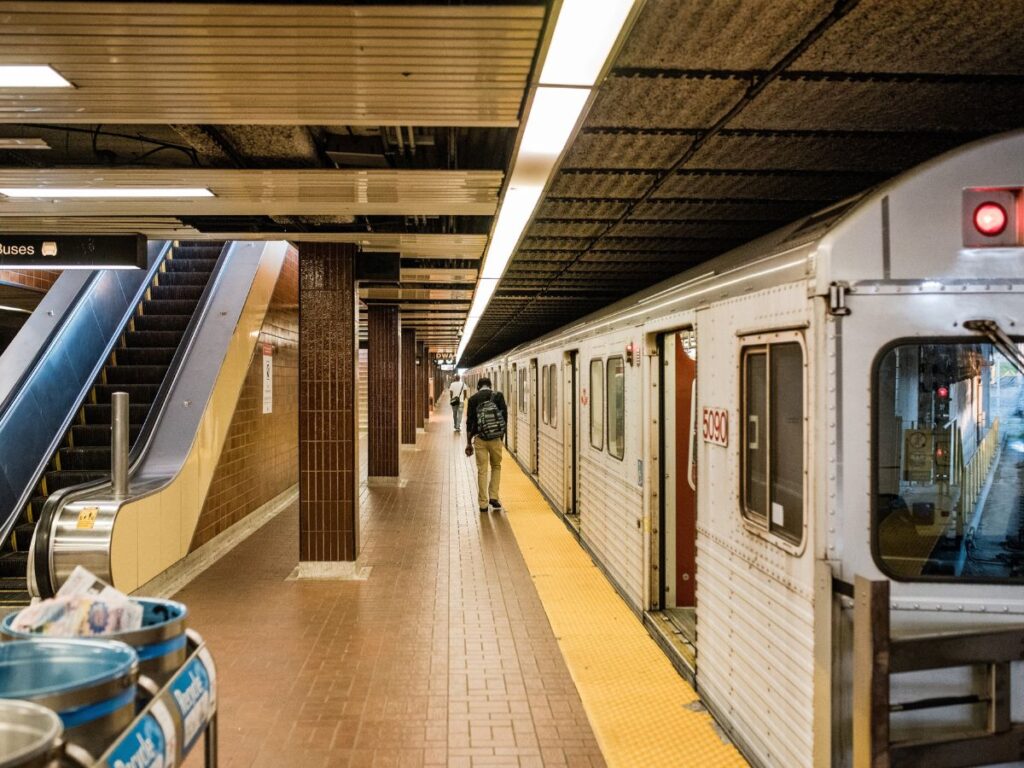In the heart of Toronto, where the bustling energy of the city meets the convenience of urban transit, lies Bloor-Yonge Station in Downtown Toronto—the busiest subway station in the region. This vital Bloor-Yonge Transit Station serves as a crucial interchange for thousands of commuters each day, making it a linchpin among public transit stations in Downtown Toronto. Since its opening in 1954, this iconic station has undergone numerous transformations, reflecting the city’s growth and the increasing demand for efficient transit. As you navigate through its vibrant concourse, you’ll discover not only its architectural quirks but also the history and community spirit that define the Bloor Yonge Subway Station. Join us as we delve deeper into what makes this station unique, its rich history, and its vital role in shaping Toronto’s public transit landscape.
Location and Accessibility
Bloor-Yonge Station in Downtown Toronto is situated at 2 Bloor Street East, positioned at the intersection of Yonge and Bloor streets. This central location makes it a strategic hub for commuters traveling across the city and a key point of access to various neighborhoods.
The station is designed with accessibility in mind, featuring seven elevators that provide access to different levels, making it easier for individuals with mobility challenges to navigate. Each entrance is equipped with accessible features, ensuring that Bloor-Yonge Station meets the needs of all passengers.
There are several significant entrances to the station:
- 20 Bloor Street East Entrance (Hudson’s Bay Centre): This entrance is on the north side of Bloor Street East, directly linking to the North Concourse level.
- 33 Bloor Street East Entrance (Xerox Centre): Located on the south side of Bloor Street East, it provides elevator and stair access to the South Concourse level.
- Hayden Street Entrance (Xerox Centre): This entrance offers additional elevator and stair access to the South Concourse.
- Yonge Street Automatic Entrance: Found on the east side of Yonge Street, this unmanned entrance leads directly to the Bloor-Danforth subway platform, accessible only to PRESTO cardholders.
- Yonge Street Entrance: Located just north of Bloor Street East, it offers stair access to the North Concourse.
- Bloor Street East Entrance (Hudson’s Bay Centre): This entrance connects to the North Concourse and is positioned 145 meters east of Yonge Street.
These entrances play a crucial role in facilitating smooth transit connections at Bloor-Yonge Station, one of the busiest public transit stations in Downtown Toronto.
Address: 2 Bloor St E, Toronto, ON M4W 1A8, Canada
Socials
Historical Significance
Bloor-Yonge Station in Downtown Toronto holds a significant place in the history of the city’s transit system. The station originally opened on March 30, 1954, as part of the Yonge subway line. Designed by British-Canadian architect Charles B. Dolphin, the station featured a straightforward layout with two side platforms, reflecting the transit needs of that era.
Over the years, the station has undergone several significant renovations to accommodate increasing ridership and improve functionality. Notably, when the Bloor-Danforth line was added in 1966, the station was reconfigured to provide seamless transfers between the two lines. Additional renovations took place in the late 1980s, which included widening the platforms and modernizing facilities to better serve the growing number of passengers.
Architectural assessments of the station have varied. In February 1985, Canadian painter Harold Barling Town criticized its aesthetics, famously describing it as looking “like a vast urinal with no relief.” This assessment highlighted the station’s lack of architectural prominence compared to other public transit stations in Downtown Toronto. Despite these criticisms, Bloor-Yonge Station has remained a vital transit hub, continually adapting to the needs of its users. Its evolution reflects both the growth of the city and the changing demands of public transit.
Station Overview
Bloor-Yonge Station in Downtown Toronto is a multi-level transit hub that features four distinct levels. The layout of the station is designed to accommodate the high volume of passengers it serves daily, ensuring efficient movement between various areas.
Platform Types
- Line 1 (Yonge-University) has side platforms, serving northbound and southbound trains.
- Line 2 (Bloor-Danforth) features a central platform that allows access to eastbound and westbound trains.
The station is equipped with several facilities to enhance the commuter experience:
- Washrooms: Located near the north end of the Line 1 southbound platform for passenger convenience.
- Elevators: A total of seven elevators provide access to different levels of the station, ensuring accessibility for all users, including those with mobility challenges.
- Escalators: Numerous escalators are strategically placed to facilitate quick movement between levels and platforms.
Additionally, Bloor-Yonge Station offers complimentary Wi-Fi, allowing passengers to stay connected while they navigate through one of the busiest public transit stations in Downtown Toronto. This combination of facilities and services makes the station a vital component of Toronto’s transit infrastructure.
Bloor-Yonge Station’s Unique Features
Bloor-Yonge Station in Downtown Toronto stands out among the city’s public transit stations for several reasons. As the busiest subway station in the region, it serves as a critical interchange point for commuters, setting it apart from other stations like St. George or Union Station.
One of the station’s distinguishing architectural elements is its dual-platform design, where Line 1 (Yonge-University) features two side platforms, while Line 2 (Bloor-Danforth) employs a central platform. This layout not only facilitates efficient transfers between lines but also highlights the unique integration of subway services at this location.
Additionally, the station employs effective signage and navigational aids to enhance the commuter experience. Illuminated signs clearly indicate platform directions and transfers, allowing passengers to navigate the busy station with ease. The use of color-coded lines on maps and the distinct labeling of platforms help reduce confusion, particularly during peak hours.
These unique features of Bloor-Yonge Station contribute significantly to its role as a vital transit hub within Toronto’s public transportation network, making it an essential stop for commuters traversing the city.

Connections and Transfers
Bloor-Yonge Station in Downtown Toronto serves as a critical transit hub, facilitating various connections for commuters. The station offers multiple transit connections, including several TTC bus routes and Blue Night streetcar services that operate in the vicinity. Buses serving the station include the 97 Yonge route, which provides northbound service to Eglinton Station and southbound service to Union Station, as well as the 300 Bloor-Danforth and 320 Yonge night routes, ensuring 24-hour transit options for passengers. For those seeking more transit options beyond Bloor-Yonge Station, our guide to the Toronto Bus Terminal covers another key hub in the city’s transportation network.
Transfer details between subway lines are a key feature of Bloor-Yonge Station. It serves as an interchange for Line 1 (Yonge-University) and Line 2 (Bloor-Danforth), allowing passengers to switch lines seamlessly. Commuters can access the Line 1 platforms via the North and South Concourses and transfer to Line 2 with minimal delays. Signage throughout the station aids in navigation, making the transfer process straightforward, even during peak hours.
This station’s strategic location and comprehensive connections make Bloor-Yonge Station one of the most significant public transit stations in Downtown Toronto. It effectively links various transit modes, providing essential service to thousands of daily riders and reinforcing its role as a major transit hub in the city’s transportation network.
Ridership and Usage Statistics
Bloor-Yonge Station in Downtown Toronto experiences exceptionally high ridership, with average weekday numbers surpassing 409,220 passengers as of 2014. This figure makes it the busiest subway station in the Toronto Transit Commission (TTC) network, significantly outpacing other public transit stations in Downtown Toronto, such as St. George and Union Station.
Over the years, ridership at Bloor-Yonge Station has shown consistent growth trends. For example, in 2019, the average weekday ridership was estimated at approximately 825,000 on Line 1, with the station playing a vital role in accommodating the increasing number of commuters. Factors contributing to this growth include population expansion in the Greater Toronto Area (GTA) and the opening of new transit lines, which have improved accessibility and connectivity.
The impact of nearby developments on station usage has been substantial. The construction of high-rise residential buildings and commercial spaces around the Bloor-Yonge intersection has led to a surge in daily passengers. These developments attract new residents and businesses, further increasing the station’s importance as a transit hub. By 2029, ridership is expected to rise even more, with estimates projecting around 280,000 passengers daily.
Recent Developments and Future Plans
Bloor-Yonge Station in Downtown Toronto is currently undergoing significant renovations to enhance its capacity and accessibility. The Bloor-Yonge Capacity Improvements Project aims to address the increasing ridership and improve passenger flow within the station. Current projects include the expansion of the existing platforms on Line 1, as well as upgrades to concourse levels and entrances to better manage the high volume of commuters.
Looking ahead, future expansion plans are set to accommodate the anticipated growth in ridership. The TTC is proposing the addition of a new eastbound platform for Line 2, which will help alleviate congestion and enhance the overall transit experience. These expansions are critical as ridership is expected to increase significantly, with projections estimating around 280,000 passengers daily by 2029.
Expected changes and improvements by 2029 will also include the installation of platform edge doors to enhance safety and efficiency. These improvements, alongside additional escalators and elevators, will make Bloor-Yonge Station one of the most accessible public transit stations in Downtown Toronto. The ongoing developments and future plans position this station as a vital transit hub, prepared to meet the demands of a growing urban population.

Trivia and Interesting Facts
Bloor-Yonge Station in Downtown Toronto is rich in history and unique features that make it stand out among the city’s transit hubs. One interesting historical anecdote is that when the station opened in 1954, it initially only had service for the Yonge line. The Bloor-Danforth line was added later, in 1966, requiring extensive renovations to accommodate the new platform layout.
Another notable feature of Bloor-Yonge Station is its distinct architectural design, characterized by its dual-platform system. Unlike many other public transit stations in Downtown Toronto, this station has a side platform for Line 1 and a center platform for Line 2, facilitating easy transfers between the two lines.
Inside the station, there are several installations that commemorate its history. One such feature is an archival photo of the original streetcar transferway, which serves as a reminder of the station’s evolution over the decades. Additionally, a reproduction of an Edwin McCormick painting honors the workers who contributed to the construction of the subway, reflecting the station’s connection to Toronto’s transit heritage.
FAQs
- How busy is Bloor-Yonge Station?
It is the busiest subway station in Toronto, handling over 409,220 passengers on an average weekday. - Is Bloor-Yonge Station accessible for people with disabilities?
Yes, the station is equipped with elevators and accessible entrances to ensure ease of access for all passengers. - Are there washrooms at Bloor-Yonge Station?
Yes, washrooms are located near the north end of the Line 1 southbound platform. - What nearby attractions can I visit from Bloor-Yonge Station?
Nearby attractions include the Toronto Reference Library, Hudson’s Bay Centre, and various shops and restaurants. Explore the best restaurants around Yonge and Bloor for top local options. For those interested in nearby library resources, the Runnymede Library in Bloor West Village is a great spot to visit after your commute through Bloor-Yonge Station. - What bus routes connect to Bloor-Yonge Station?
Key bus routes include the 97 Yonge, 300 Bloor-Danforth, and 320 Yonge night service. - Is there Wi-Fi available at Bloor-Yonge Station?
Yes, the station offers free Wi-Fi for passengers. - When did Bloor-Yonge Station first open?
The station opened on March 30, 1954, initially serving only the Yonge line. - What is the expected ridership growth for Bloor-Yonge Station by 2029?
Ridership is expected to increase to approximately 280,000 passengers daily by 2029.